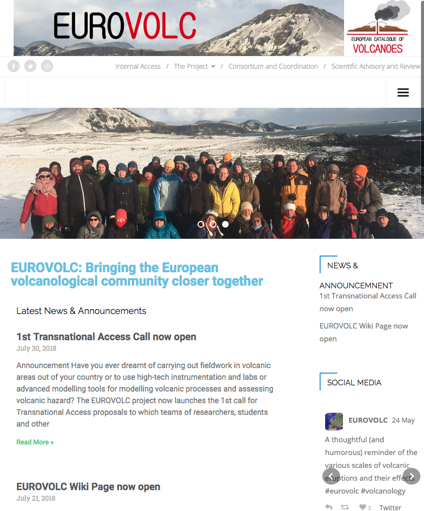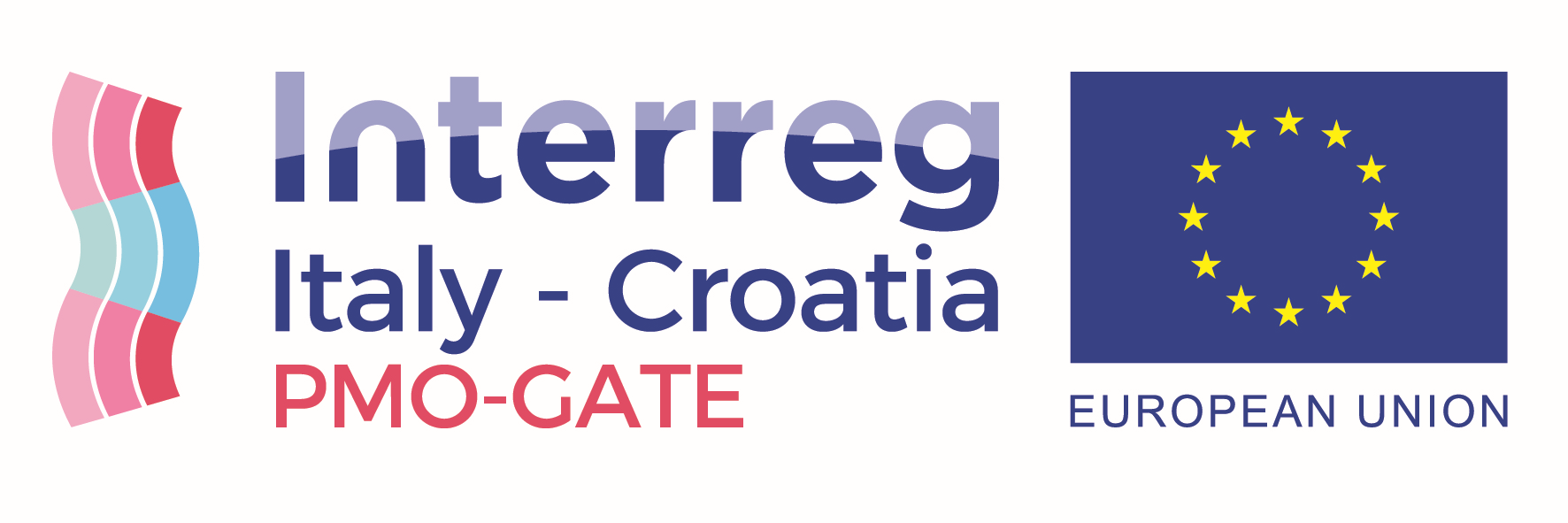
EUROVOLC: Bringing the European volcanological community closer together
EUROVOLC: Bringing the European volcanological community closer together


The European Network of Observatories and Research Infrastructures for Volcanology (EUROVOLC) is a H2020 Research and Innovation Project of the European Commission. It will construct an integrated and harmonized European volcanological community able to fully support, exploit and build-upon existing and emerging national and pan-European research infrastructures, including e-Infrastructures of the European Supersite volcanoes. The harmonization includes linking scientists and stakeholders and connecting still isolated volcanological infrastructures located at in situ volcano observatories (VO) and volcanological research institutions (VRIs).
For this purpose, EUROVOLC will carry out Networking and Joint Research activities, and offer Trans-national and Virtual Access to the main European Volcano Observatories and Volcano Research Infrastructures. These activities will address four broad transversal Themes – ‘Community building, Volcano-Atmosphere interaction, Sub-surface progress, and Volcanic crisis preparedness and risk management’ of particular interest to the overall Earth Science community.
INGV is a full partner of the EUROVOLC project. Our team (about 50 people) contributes to this project through the participation in 16 Work Packages. More specifically, INGV leads six WPs and sixty Tasks. Our participation is on all project’s Themes (Community Building, Volcano-atmosphere interaction, Sub-surface processes, and Volcanic crisis preparedness and risk management). Furthermore, INGV contribute to the project management by coordinating all the Transnational and Virtual Accesses activities (12 WPs and 10 partners).
The EUROVOLC consortium includes volcano observatories in Europe responsible for surveillance of volcanoes and for providing advice on their activity in Italy, Iceland, Portugal (the Azores), Greece (volcanic islands) and France (overseas territories), as well as additional partners responsible for providing advice to authorities on volcanic risk and hazard. This consortium of VOs comprises all volcano observatories in Europe (see Figure below).
Detailed information on the EUROVOLC project and its latest developments, including Calls for applications for Trans-national and Virtual Access, can be monitored closely on the EUROVOLC website: https://EUROVOLC.eu. The EUROVOLC project can also be followed on social media through the dedicated #eurovolc and @eurovolc usernames on Twitter and Instagram, and Facebook.

Geographical distribution of European volcanoes (red circles): on the European continents,
plus Canary islands (left) and in overseas countries (right)
PROGETTI
Progetti INGV e progetti Dipartimentali
Progetto EUROVOLC: Bringing the European volcanological community closer together
Progetti finanziati dal Dipartimento della Protezione Civile
Progetti a finanziamento esterno e Convenzioni DPC
Progetti di Ricerca Libera
Progetti di Ricerca Libera bando 2019
Progetti di Ricerca Libera bando 2023
Elenco dettagliato Progetti e Convenzioni (accesso riservato solo ad utenti INGV)

PMO-GATE - Preventing, Managing and Overcoming Natural-Hazards Risks to mitiGATE economic and social impact

ABSTRACT
Accrescere la sicurezza e la resilienza in caso di disastri dovuti a pericoli naturali richiede conoscenza e consapevolezza dei rischi (Sendai Framework for Disaster Risk Reduction 2015-2030). Gli obiettivi generali del presente progetto sono: sviluppare congiuntamente una metodologia innovativa per la prevenzione, la gestione e il superamento delle catastrofi naturali multirischio nella Regione Italia-Croazia (da qui in poi IT-HR REG), e aumentare il livello di protezione e di resilienza contro i disastri naturali specifici della Regione, come le inondazioni fluviali e marine, i meteo-tsunami e i terremoti.
L'approccio proposto si basa sull'integrazione tra la valutazione del rischio, la prevenzione, la preparazione e le azioni di risposta contro i pericoli naturali rilevanti, utilizzando il maggior numero possibile di dati e risultati disponibili da studi precedenti, evitando la duplicazione di studi passati e esistenti. I tre pilastri dell'approccio sono:
- capitalizzazione del patrimonio di competenze disponibili nella IT-HR REG nella gestione dei pericoli naturali;
- definizione di scenari probabilistici con analisi dettagliate delle vulnerabilità territoriali nel rispetto della legislazione comunitaria che disciplina la Valutazione Ambientale Strategica;
- strategie di comunicazione efficaci che aumentano la consapevolezza e la percezione nella popolazione e nelle autorità pubbliche, attraverso una conversazione a due vie tra IT-HR REG e i membri della comunità interessata (EPA).
L’approccio che si propone PMO-GATE è quello di una collaborazione tra nazioni confinanti, nella convinzione che promuovere una metodologia unificata, multidisciplinare e integrata per affrontaere sfide comuni per le sfide comuni può portare a realizzare cambiamenti significativi.
Metodologie e mappe multirischio sono attualmente già disponibili in letteratura, come descritto nella sezione “Building on the existence knowledge".
L'approccio proposto in PMO-GATE è originale per due motivi:
- i dati e i piani di rischio saranno integrati a livello transfrontaliero con un approccio bottom-up rispettoso delle reali sfide territoriali IT-HR, vale a dire tenendo conto dei multirischi a livello urbano, extra-urbano e rurale;
- si analizzeranno contemporaneamente nella stessa area sia l’hazard derivato da effetti climatici (inondazioni, meteo-tsunami) che quello dovuto a fattori sismici e quindi non legati al clima.
I risultati finali saranno un piano di gestione del rischio volto a superare le condizioni di emergenza con il minor impatto sociale ed economico possibile, e lo sviluppo di sistemi di allarme rapido per migliorare la sicurezza e la resilienza.
Qundi, in generale, il presente progetto permetterà di prevenire, gestire e superare i rischi naturali, di proteggere le vite umane e il patrimonio socio-economico e socio-culturale.
L’INGV è partner nel progetto PMO-GATE e il suo contributo porterà ad una migliore conoscenza dell’hazard da tsunami e meteotsunami nelle coste orientali e occidentali dell’Adriatico. L’attività dell’INGV in seno al progetto consentirà di ottenere un quadro completo dell’attività di tsunami e meteo-tsunami nel passato, allo scopo di identificare quli sono le aree costiere adriatiche più interessate da questi fenomeni. Le conoscenze che si acquisiranno portanno fornire un contributo per la validazione degli studi di hazard da tsunami.
DETTAGLI DEL PROGETTO
Coordinatore: Elena Benvenuti, Università di Ferrara
Obiettivo specifico: Accrescere la sicurezza nei confronti di disastri naturali e antropici, nell’area coperta dal Programma
Finanziatore: CBC Programme Italy-Croatia
Call: INTERREG V A Italy – Croatia CBC Programme - 2017 Standard - Priority Axis: Safety and resilience
Data di inizio 01/01/2019 - scadenza 30/06/2021
Contributo EU: 1.429.112,05 €
Contributo EU all’INGV: 98.249,55 €
PARTECIPANTI
• Università di Ferrara, (coordinatore)
• Università di Split, Croazia
• Istituzione Pubblica Rera Sd per il Coordinamento e lo Sviluppo della Regione Dalmata, Croazia
• Istituto Nazionale di Geofisica e Vulcanologia - INGV, Roma
• Istituto Nazionale di Oceanografia e Geofisica Sperimentale - OGS, Trieste
• Città di Kaštela, Croazia
• Comune di Ferrara
Responsabile INGV:
Alessandra Maramai
Sito del Progetto
ABSTRACT
Enhancing safety and resilience for disasters due to natural hazards requires risks knowledge and awareness (Sendai Framework for Disaster Risk Reduction 2015-2030).
The overall objectives of the present project are: to jointly develop an innovative methodology for preventing, managing and overcoming multi-hazard natural disasters in the involved Italy-Croatia NUTS (from here on IT-HR NUTS), and to increase the level of protection and resilience against natural disasters specific of the IT-HR NUTS, such as river and sea floods, meteo-tsunamis, and earthquakes.
The proposed approach is based on the integration among risk evaluation, prevention, preparedness and response actions against relevant natural hazards using as much as possible data and results available from previous studies, avoiding duplication of past and existing studies. The three pillars of the approach are:
- capitalization of the available heritage of expertise of IT-HR NUTS in natural hazards management;
- definition of probabilistic scenarios with detailed analysis of the territorial vulnerabilities in the respect of the community legislation governing the Strategic Environmental Assessment;
- effective communication strategies that increase awareness and perception in population and public agencies, through a two-way conversation between IT-HR NUTS and affected community members (EPA).
A cross-border approach is necessary to foster a unified methodology to common challenges, in the conviction that the proposed cross-border, multidisciplinary, and integrated partnerships will achieve tangible changes.
Multi-risk methodologies and maps are available, as described in the "Building on the existence knowledge" section.
The proposed approach is original for two reasons:
- data and risk plans will be integrated on a cross-border level with a bottom-up approach respectful of the real IT-HR territorial challenges, namely taking into account peculiar multi-hazards at the urban, extra-urban, and rural level.
- climate induced hazards (floods, meteo-tsunamis) will be combined with non-climate induced seismic vulnerability.
The final outputs will be: a plan of risk management aimed at overcoming the emergency conditions with the least possible social and economic impact, and the development of early warning systems to enhance safety and resilience.
Globally, the present project will allow to prevent, manage and overcome natural hazard risks, safe-guard human lives and socio-economic and the socio-cultural heritage.
INGV is a partner in the PMO GATE project and it will contribute to the knowledge on tsunami hazard along both the Eastern and Western Adriatic coasts. The INGV research will provide a complete picture of tsunamis and meteo-tsunamis activity occurred in the past, in order to identify the portions of the Adriatic coasts most affected by these events. The knowledge achieved could be a fundamental contribution for the validation of tsunami hazard studies.
PROJECT DETAILS
Project coordinator: Elena Benvenuti, University of Ferrara
Specific objective: Increase the safety of the Programme area from natural and man-made disaster
Funding source: CBC Programme Italy-Croatia
Call: INTERREG V A Italy – Croatia CBC Programme - 2017 Standard - Priority Axis: Safety and resilience
Start date 01/01/2019 - end date 30/06/2021
EU contribution: 1.429.112,05 €
EU contribution to INGV: 98.249,55 €
PARTECIPANTS
• University of Ferrara, Italy (coordinator)
• University of Split, Croatia
• Public Institution Rera Sd for Coordination and Development of Split Dalmatia County, Croatia
• National Institute of Oceanography and Experimental Geophysics – OGS, Italy
• National Institute of Geophisics and Volcanology - INGV, Italy
• City of Kaštela, Croatia
• Municipality of Ferrara, Italy
INGV Coordinator:
Alessandra Maramai
Website ..
Progetti DPC Convenzione 2007-2009
Nell’ambito del punto C dell’art. 5 comma 2 della Convenzione-quadro 2007-2009, e in analogia con quanto già attuato con successo nell’ambito della Convenzione 2004-2006, l’INGV propone una serie di progetti di ricerca finalizzati al conseguimento di specifici obiettivi di interesse per il DPC, da svolgere in parte con forze interne all’Ente ed in parte promuovendo il contributo della comunità scientifica esterna all’Ente stesso.
- Progetti Sismologici
- Progetti Vulcanologici
- Progetto Misto
- Documenti
Sottocategorie


